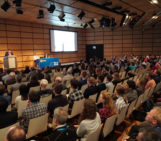One way to improve the impact of your scientific research is to engage with policy. Doing so can create new opportunities for yourself and your research. The main challenges are knowing when and how to effectively communicate scientific results to policy. If the wrong timing or communication method is chosen then results are less likely to be incorporated into the policy process. This month’s GeoPolicy post takes a look at the policy cycle and how science can be included to strengthen this practice.
Why is the policy cycle used?
The policy cycle is an idealised process that explains how policy should be drafted, implemented and assessed. It serves more as an instructive guide for those new to policy rather than a practical strictly-defined process, but many organisations aim to complete policies using the policy cycle as an ideal.
Where is science involved?
Science can have a supportive role in every step of the policy cycle. In fact, novel scientific discoveries can sometimes be the instigator to forming new policies. The classic example of this is the ozone hole discovery in 1985 by British Antarctic Survey scientists, Joesph Farman, Brian Gardiner, and Jonathan Shanklin. After a series of rigorous meetings and negotiations by scientists, policy officials, and politicians, the Montreal Protocol on Substances that Deplete the Ozone Layer was signed on 16 September 1987. Without scientific evidence the Montreal Protocol would never have been created.
What are the stages of the policy cycle?
The policy cycle is made up of roughly 6 stages and science can be incorporated into every step. How science supports these different stages are described below.

The policy cycle showing where different types of scientific advice can be given. Gif created at http://gifmaker.me/.
- Agenda Setting: This step identifies new issues that may require government action. If multiple areas are identified they all can be assessed, or particular issues may be given a priority.
- Scientific Input: As described above, new scientific results can be the foundation for forming new policies. Additionally, new focus areas can be anticipated through so-called ‘horizon / foresight scanning’ events that aim to identify emerging issues of policy-relevance.
- Example: The government may want to increase energy production from renewable sources. This could be through increased solar panel production and usage.
- Formulation: This step defines the structure of the policy. What goals need to be achieved? Will there be additional implications? What will the costs be? How will key stakeholders react to these effects?
- Scientific Input: Science can be incorporated in this stage through Impact Assessments, which aim to comprehensively assess what effects will occur from a potential policy. These assessments can study multiple strategies to identify the optimum policy.
- Example: Should governments offer tax-breaks to start-up renewable energy companies? Or should they offer individual subsidies to solar panel buyers? What might be the effects of these actions?
- Adoption: Once the appropriate approval (governmental, legislative, referendum voting etc.) is granted then a policy can be adopted.
- Science Input: Those in charge of approving a certain policy will often seek external advice that is independent to those who drafted the policy. Scientists can be called upon to offer advice within the decision-making process.
- Example: A nation-wide policy can be implemented by the national government, but changing a law will require a vote in Parliament.
- Implementation: Establishing that the correct partners have the resources and knowledge to implement the policy. This could involve creating an external organisation to carry out actions. Monitoring to ensure correct policy implementation is also necessary.
- Scientific Input: Scientific advice can be needed to logistically support the policy being implemented. Scientists can provide methodological guidance to policy workers and advisory bodies who implement the policy.
- Example: Administration processes to allow organisations and individuals to apply for subsidies / tax benefits need to be created.
- Evaluation: This step assesses the effectiveness and success of the policy. Did any unpredicted effects occur? These assessments can be quantitative and/or qualitative.
- Scientific Input: Scientists can evaluate the efficiency and effectiveness of policies. This can be done independently or working with policy implementers.
- Example: The UK and Germany introduced highly popular solar energy policies. Energy production at certain times of the day and year have substantially increased. Occasionally more energy is being produced than is needed, which now leads to further questions about how to handle the ‘excess’ energy.
- Support / Maintenance: This step studies how the policy might be developed, or provides additional support for its continuation. Additionally, the policy can be terminated if deemed redundant, accomplished, or ineffective.
- Scientific Input: As a policy is continued, scientific advice may be needed on an ad-hoc basis. Updated feedback can be given when needed to help maintain and improve policies.
- Example: Even if a policy is considered a success, should it be continued? Should solar panel policies be continued, or should policies now focus on improving national electric grids, or should energy storage policies be developed instead?
Remember that scientists should only offer a supportive role to the policy cycle. They should present only the current state of scientific knowledge. Policy officials are the decision makers.
Policy cycle shortcomings
The policy cycle has been described as a theoretical concept that it not fully translatable to real world applications. Sometimes, some stages of the cycle are never delivered. Without scientists some of the stages are difficult to accomplish, therefore scientists are in a position to strengthen the policy cycle’s structure through expert advice and assistance.
Sources / Further reading
Policy Concepts in 1000 Words: The Policy Cycle and its Stages
GeoPolicy: 8 ways to engage with policy makers
GeoPolicy: How to communicate science to policy officials – tips and tricks from the experts





Pingback: Rational & Incremental policy-making | Jason Deegan